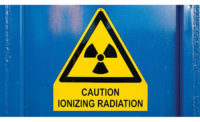Radiation sources are found in a wide range of occupational settings, according to OSHA.
Non-ionizing radiation includes the spectrum of ultraviolet (UV), visible light, infrared (IR), microwave (MW), radio frequency (RF), and extremely low frequency (ELF). Lasers commonly operate in the UV, visible, and IR frequencies
• Extremely Low Frequency (ELF) radiation at 60 HZ is produced by power lines, electrical wiring, and electrical equipment. Common sources of intense exposure include ELF induction furnaces and high-voltage power lines.
• Microwave radiation (MW) is absorbed near the skin, while Radiofrequency (RF) radiation may be absorbed throughout the body. At high enough intensity both will damage tissue through heating. Sources of RF and MW radiation include radio emitters and cell phones.
• The skin and eyes absorb infrared radiation (IR) as heat. Workers normally notice excessive exposure through heat sensation and pain. Sources of IR radiation include furnaces, heat lamps, and IR lasers.
• The different visible frequencies of the electromagnetic (EM) spectrum are “seen” by our eyes as different colors. Good lighting is conducive to increased production, and may help prevent incidents related to poor lighting conditions. Excessive visible radiation can damage the eyes and skin.
• Ultraviolet radiation (UV) has a high photon energy range and is particularly hazardous because there are usually no immediate symptoms of excessive exposure. Sources of UV radiation include the sun, black lights, welding arcs, and UV lasers.
• Lasers typically emit optical (UV, visible light, IR) radiations and are primarily an eye and skin hazard. Common lasers include CO2 IR laser; helium - neon, neodymium YAG, and ruby visible lasers, and the Nitrogen UV laser.
Ionizing radiation sources may be found in health care facilities, research institutions, nuclear reactors and their support facilities, nuclear weapon production facilities, and other various manufacturing settings, just to name a few.
If not properly controlled, radiation can be potentially hazardous to the health of workers.
Effects of radiation
There is disagreement, even among experts, regarding the safety of low levels of radiation. In an effort to clarify concerns regarding radiation exposure, on its Radiation Answers website (www.radiationanswers.org), the Health Physics Society — a nonprofit scientific professional organization focused on radiation safety — presents the following information.
Radiation dose
Radiation specialists use the unit “rem” (or sievert) to describe the amount of radiation dose someone received. Without getting technical, it indicates a measure of how much radiation energy is absorbed in the body. The total energy absorbed and its effectiveness in causing change is the basis for determining whether health effects may result.
As a baseline:
• 1 rem received in a short period or over a long period is safe — no observable health effects are expected.
• 10 rem received in a short period or over a long period is safe — no immediate observable health effects are expected, although your chances of getting cancer might be very slightly increased.
• 100 rem received in a short time can cause observable health effects from which your body will likely recover, and 100 rem received in a short time or over many years will increase your chances of getting cancer.
• 1,000 rem in a short or long period of time will cause immediately observable health effects and is likely to cause death.
Safe or not?
Radiation can cause biological changes in human cells, and these can be seen in a laboratory even when the dose is small. However, these changes are not seen or cannot be related to health effects in humans. The fact that changes can occur may make some people believe all radiation is bad, and the fact that this is not related to human health effects may make others believe it is safe at low levels. Human health effects that have been observed have been when individuals or groups have received larger doses of radiation (more than 50 rem) from events like those due to military uses of nuclear weapons, accidents, and uses of radiation in medicine for therapy.
If a population receives a radiation dose of 100 rem in a short period of time, health effects are expected in some people who were exposed. However, many who receive a dose at that level will not have any long-lasting health effects. This can be compared to eating a high-cholesterol, high-fat diet — some who eat this way end up with heart disease, while others do not.
There are some things experts can say with certainty that apply to a majority of the population. For a small radiation dose (<10 rem), the risk of cancer is very small, too small to have any observable health impact in the population of the U.S. If the radiation dose is quite large and given in a short period of time, like 1,000 rem, it will cause an individual to be very sick and die. To learn more, visit www.radiationanswers.org/radiation-and-me/effects-of-radiation.html.



